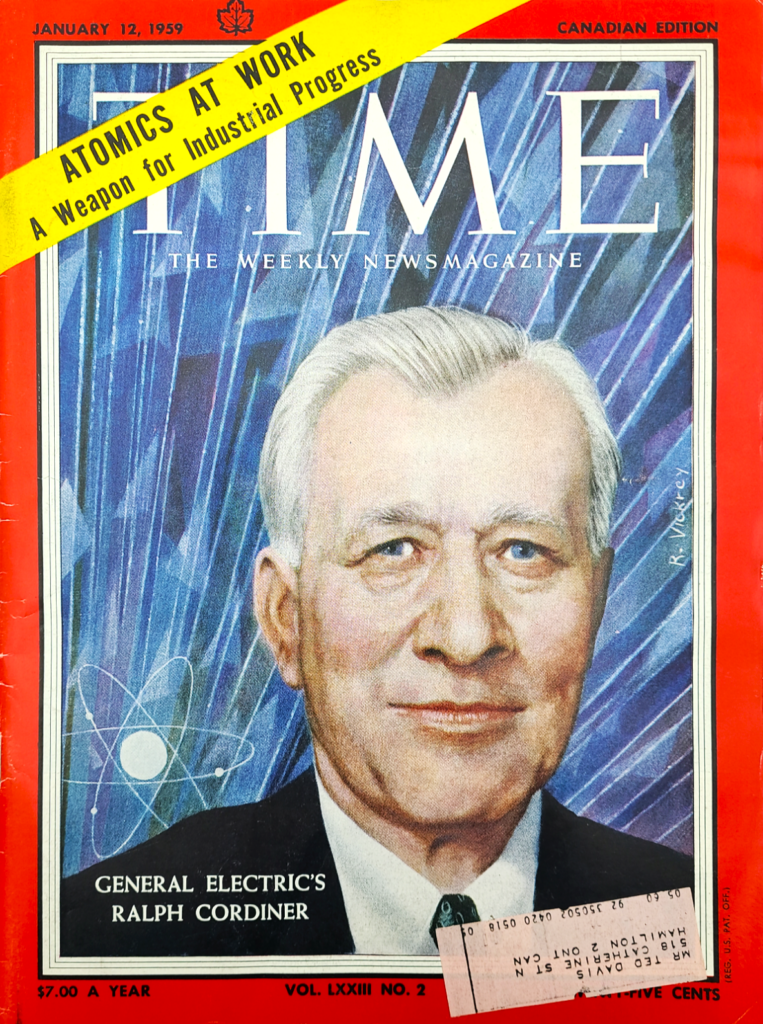General Electric's Ralph Cordiner
The cover story from this week’s TIME magazine highlights the approach that Ralph Cordiner brought to the management of General Electric (GE). Cordiner was born and raised on a farm near Walla Walla, Wash., and later attended Whitman College. After school, Cordiner began working as a salesman for Pacific Power. Eventually, he went to work for Edison General Electric Appliance Co., a subsidiary of General Electric.
During his initial stint with General Electric, Cordiner worked his way up through the company to become the Bridgeport Boss. However, the centralized management structure that existed at the time limited Cordiner from implementing his own management ideas. Frustrated, he left in 1939 to become president of Schick Inc.
Cordiner returned to GE in 1942 and soon after was given permission to start implementing his plan for decentralization. By 1951 Ralph Cordiner was the only candidate recommended to the board as replacement for the retiring company president. He commented to TIME and said “I told lots of people immediately that this company was not going to be a sinecure for mediocrity. The old G.E. had a reputation as a good and complacent place to work if you kept your nose clean. I wanted to get rid of that idea and create more risk and opportunity.”
The intention was to create a structure that allowed Cordiner and his immediate team to focus on the next generation of business 15-20 years in the future. He would trust the division heads to focus on the more immediate concerns. In order to do this, Cordiner split GE into 27 divisions. Each division was like an independent business big enough for one person to manage. The head of each division was responsible for the day-to-day operation of their division. There was enough freedom that they could handle their own marketing, budget, set prices and make capital expenditures up to a set limit.
To reinforce the decentralized system that Cordiner established, there was significant investment put into executive training. A large facility was created for training by doctors in psychology, sociology, even anthropology, to teach executives the demands and duties of this new management revolution.
Under Ralph Cordiner GE was looking to the future. In 1959 they put the nation’s first privately owned test reactor into operation. GE was the biggest U.S. electrical company and the world’s largest power equipment supplier. The company produced everything from toasters to jet engines.
This TIME article characterized Ralph Cordiner as “a short (5 ft. 7½ in.), power-packed man with restless eyes that are always trained on the future, ever watchful for risk and opportunity.” Cordiner himself said “Civilization is moved forward by restless people, not by those who are satisfied by things as they are.” and “The atom is the power of the future—and power is the business of General Electric.”
In 1959 GE was already looking beyond atomic power. They were working towards the more revolutionary power of fusion. Fusion, could provide mankind with unlimited power. At the time this magazine issue was published, they estimated that fusion was still three or four years away, and any practical results would come years later.
President Eisenhower welcomes Alaska to Statehood
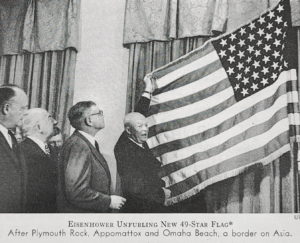 President Eisenhower was busy this week. On January 3, 1959 at 12:01 p.m., the President signed the proclamation that admitted Alaska to the Union as the 49th state. Up until this point, Alaska had been an American territory. I believe the small population among other issues is what prevented Alaska from becoming a state until 1959.
President Eisenhower was busy this week. On January 3, 1959 at 12:01 p.m., the President signed the proclamation that admitted Alaska to the Union as the 49th state. Up until this point, Alaska had been an American territory. I believe the small population among other issues is what prevented Alaska from becoming a state until 1959.
Alaska was seen as a massive source of natural resources, but also was strategically important because of its proximity to Russia and Asia. The U.S. also picked up in Alaska its first non-contiguous state.
Immediately after, the President signed an executive order designating a new 49-star national flag to become official on the Fourth of July. The design of the new flag included seven staggered rows of seven white stars set in a blue canton within the field of 13 alternate red and white stripes. As a bonus, an additional star could be added to the flag without much difficulty. This was handy because Hawaii was set to become the 50th state later in 1959.
In a weird coincidence, Jen turned on Happy Days this week (A show we never watch) and they were throwing a Hawaiian party to celebrate it’s becoming a state. When it was too cold, they decided to make it an Alaska party.
Transition in Cuba
In Cuba, General Fulgencio Batista’s dictatorship had just come to an end on New Year’s Eve. This was a conclusion to the 1956 invasion by Rebel Fidel Castro. Castro initially arrived with only 81 men and an intention to take over an island that had a population of 6.5 million.
General Batista’s army used a strategy that included torturing rebel suspects and shipping dismembered bodies of students home to their mothers. These terror tactics backfired and resulted in Castro receiving an abundance of support through arms supplies and new recruits.
In the end, Batista and his supporters fled from Cuba. Batista himself went to the Dominican Republic with his wife and one son. He had seven other children who were spread out in U.S. states. Wherever Batista supporters landed in the U.S., they encountered Cuban exiles who turned out to hoot and jeer at them. Other Cubans who were in exile, boarded planes and happily returned to Cuba.
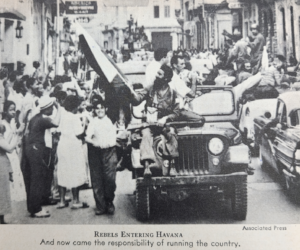 As news spread that Batista was out, the people of Havana put on arm bands in support of the rebels. Thousands of Cuban citizens celebrated in the streets, firing guns in the air. They dressed in the red and black rebel colors while cheering through the Havana University. Meanwhile, rioters sacked the homes and businesses of Batista supporters.
As news spread that Batista was out, the people of Havana put on arm bands in support of the rebels. Thousands of Cuban citizens celebrated in the streets, firing guns in the air. They dressed in the red and black rebel colors while cheering through the Havana University. Meanwhile, rioters sacked the homes and businesses of Batista supporters.
Soon after the rebels took control, political prisoners were released. Hundreds of U.S. tourists returned home, rebels loading their luggage onto the ferry.
TIME reported that Fidel Castro’s “movement would have to reorganize Cuba and try to run its government; he promised that the rebels would permit the harvesting of the vital sugar crop and restore constitutional rights. But he would not personally run the show, he said. ‘Power does not interest me, and I will not take it,’ he vowed. ‘From now on, the people are entirely free, and our people know how to comport themselves properly.’”
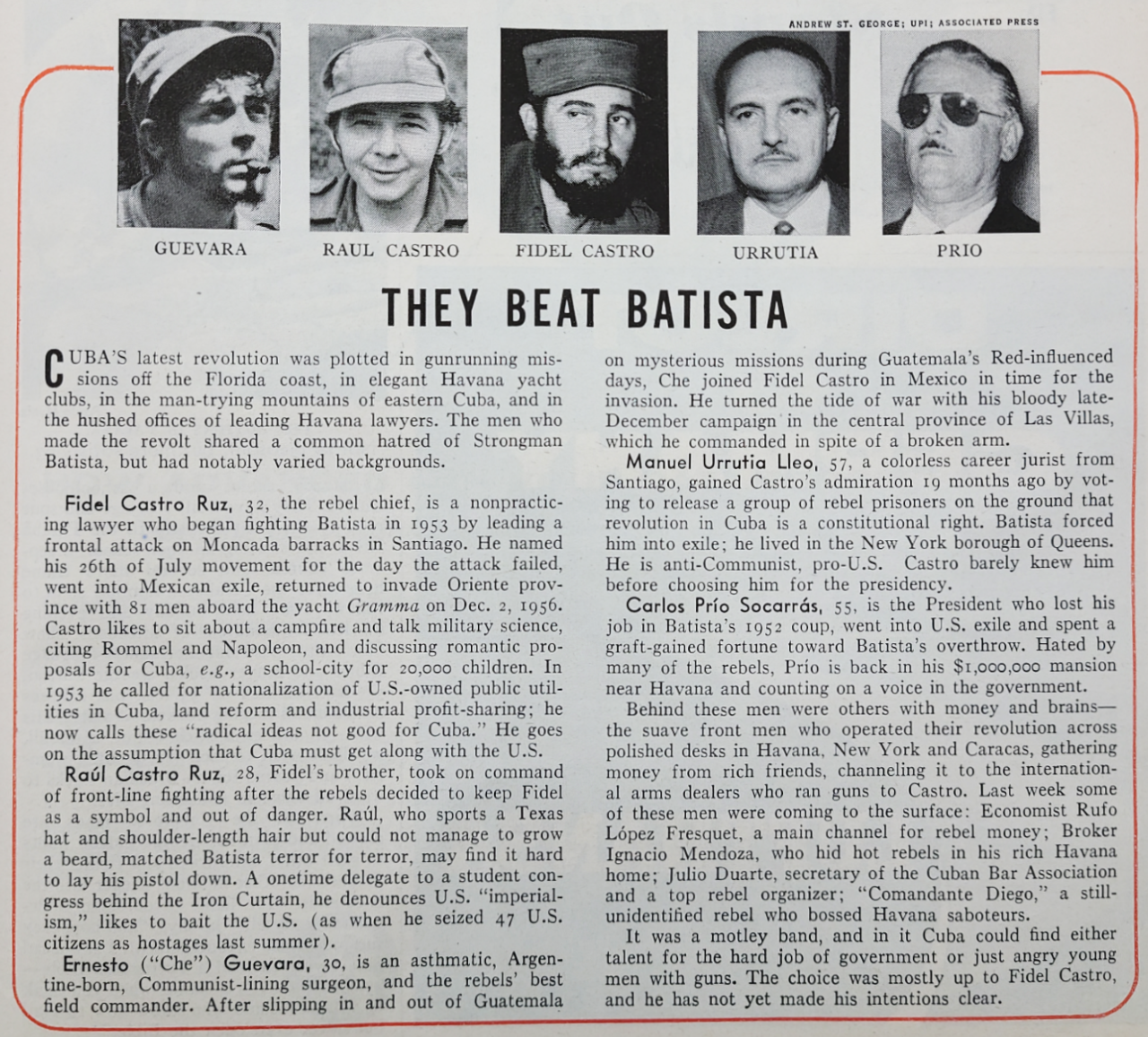
Space Exploration - The First Object to break free of Earth's Gravitational Pull
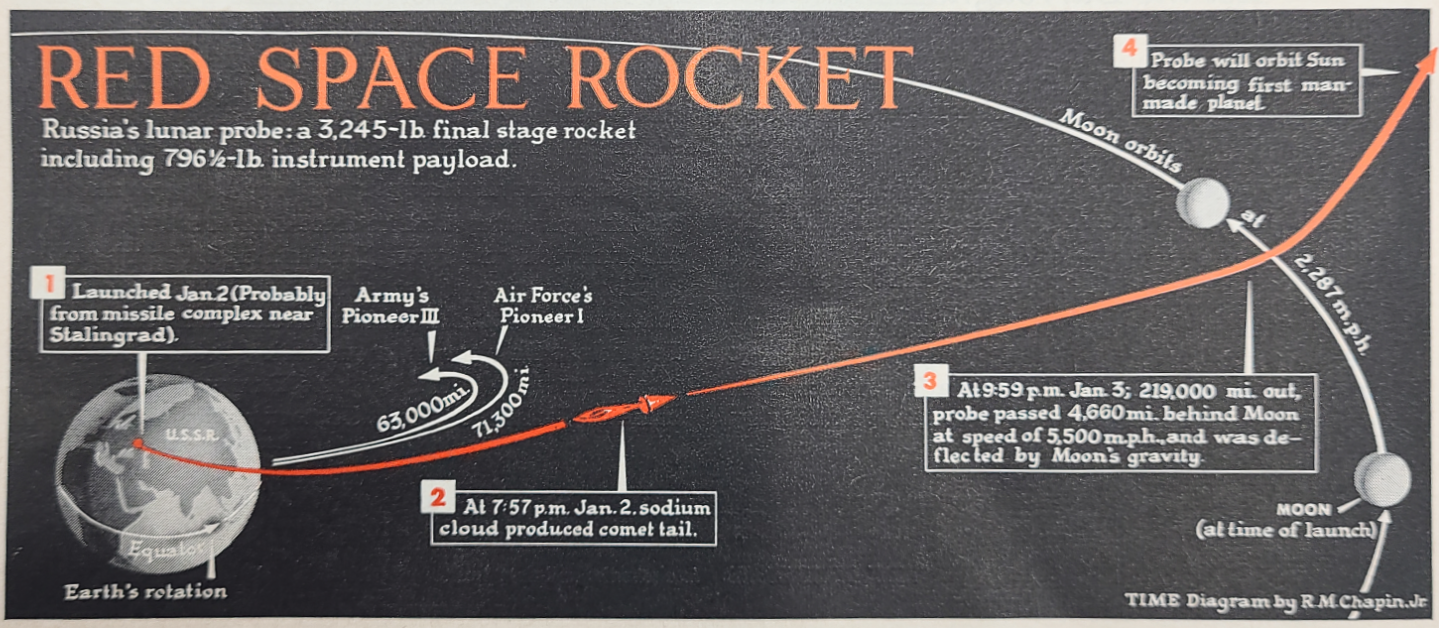 The 1950’s and 1960’s were and exciting time for space exploration. There were a lot of firsts, many big new accomplishments and of course the race between the Soviet Union and United States. The excitement around these events captured the imagination of nations. It can be seen reflected in everyday life through movies to vehicle design and more.
The 1950’s and 1960’s were and exciting time for space exploration. There were a lot of firsts, many big new accomplishments and of course the race between the Soviet Union and United States. The excitement around these events captured the imagination of nations. It can be seen reflected in everyday life through movies to vehicle design and more.
This week saw another big first in space exploration. The Soviet Union was the first to send an object into space and have it break free of Earth’s gravitational pull. Their moon-probe missile, known as Lunik, the First Cosmic Ship or Luna 1, passed by the moon and headed into orbit around the sun.
The object was expected to complete the route around the sun approximately every 15 months. Along the way it would send back radio transmissions on multiple frequencies. These radio transmissions included information detected by various onboard sensors detailing cosmic ray observations, measurements of gas in interplanetary space, recorded impacts of particles coming from the sun, measurements of the moon’s magnetic field and reports on the radioactivity of the moon’s surface.
Unfortunately, Luna 1 ran out of battery power on January 5, 1959, just under 400,000 Miles from Earth. Luna 1 is believed to be still orbiting the sun between the orbits of Earth and Mars.
Research into the relationship between smoking and cancer
Today most people are aware of the risks related to smoking. Packaging labels provide graphic warnings that inform the consumer of the potential risks. There has been an understood link to smoking and cancer as far back as the 1920’s; however, in 1959 there was still not a clear understanding with regards to what aspect of smoking was the root cause for the associated health risks.
In this article, researchers have determined that the tar from pipes and cigars is as potent of a cancer-causing agent as cigarettes. These studies were trying to determine if it was the tobacco tar itself, or potentially something in the cigarette paper that was the cancer-causing agent.
Apparently, the skin on mice is essentially the same structurally as the inside of a person’s lungs and has similar reactions. As a result, the study was performed by shaving the backs of mice and applying tar from pipes, cigars and cigarettes (rolled in tobacco leaf instead of paper). Researchers then assessed the number of cancers on each group of mice and concluded that there was no difference between the various sources of tar.
This study seemed to eliminate paper as a source of cancer and helped researchers conclude that there must be other dangerous substances within tobacco. The final assessment established that these dangerous substances would need to be removed from tobacco to ensure that smoking could be eliminated as a cause for cancer. Despite the known health risks, it took decades longer to take action and properly educate the public.
This Week In Sports - The Bowls
- No. 1 ranked Louisiana State barely hung on to beat Clemson 7-0 in the Sugar Bowl.
- Texas Christian played to a scoreless tie against the Air Force Academy in the Cotton Bowl.
- Oklahoma comfortably defeated Syracuse 21-6 Orange Bowl.
- Iowa was the most dominant in their 38-12 win over California in the Rose Bowl.
Movies of the Week
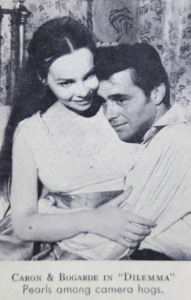 The Doctor’s Dilemma – British comedy-drama starring Leslie Caron and Dirk Bogarde. It is based on the 1906 play The Doctor’s Dilemma by George Bernard Shaw. Described in TIME as a “pertly entertaining piece of photographed theater.”
The Doctor’s Dilemma – British comedy-drama starring Leslie Caron and Dirk Bogarde. It is based on the 1906 play The Doctor’s Dilemma by George Bernard Shaw. Described in TIME as a “pertly entertaining piece of photographed theater.”
Some Came Running – American drama starring Frank Sinatra, Dean Martin, and Shirley MacLaine, based on the 1957 novel of the same name by James Jones. TIME speculates that this film was not nearly as successful as the book due to censorship.
Rally Round the Flag, Boys! – American comedy based on the 1957 novel of the same name by Max Shulman. Staring Paul Newman, Joanne Woodward, Joan Collins, and Jack Carson. The TIME description states it “fizzes like an overheated bottle of pop”.
Wrap up
Follow us here at This Week In Time or explore our shop Presents From The Past Antiques (PFTPAntiques) to start your own journey through time. Next week we will look at the January 18, 1982 issue highlighting the emerging world of video games.
We would love to here from our readers about their own memories from this time. What do you remember about the events covered? How does it make you feel when thinking about the progress or lack of progress that has been made since 12 January 1959?
